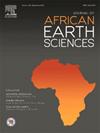Structural evolution of the Boni shear zone (BoSZ): Implications for gold mineral exploration in southwestern Burkina Faso
IF 2.2
4区 地球科学
Q2 GEOSCIENCES, MULTIDISCIPLINARY
引用次数: 0
Abstract
The Boni Shear Zone (BoSZ) has garnered significant interest from the geological exploration community following the Siou gold deposit discovery in the Mana gold district, southwestern Burkina Faso. The BoSZ represents a sheared contact separating the “Tarkwaian-type” metasedimentary sequences and the “Birimian-type” metavolcanic and metavolcano-sedimentary assemblages of the Houndé belt. The primary objective of this work is to elucidate the structural setting of the BoSZ and its control on gold mineralization. To achieve this, field work data, airborne geophysical data and satellite images have been interpreted and integrated. The initial deformation phase (D1) occurred as an E-W directed regional shortening. Subsequent phase (D2) developed transpressional dynamics under a NNW-SSE shortening, which is mainly documented within shear-zone-hosted coarse-clastic metasedimentary rocks. The last and minor phase (D3) developed a minor crenulation cleavage. Several sets of shear zones formed during D2: the older set is the NE-trending dextral strike-slip Bagassi shear zones (BaSZ). The main set, of regional extent, corresponds to the N-S trending sinistral transpressive Boni shear zones (BoSZ). It includes an anastomosing network of mylonite alternating with undeformed macro/microlithons. The last set, possible conjugate with the BoSZ, is localized nearby the Bagassi pluton and consists of the brittle-ductile NW-trending sinistral Yaramoko shear zones (YaSZ). All sets hosts gold mineralization.
博尼剪切带的构造演化:对布基纳法索西南部金矿找矿的启示
在布基纳法索西南部的Mana金矿区发现Siou金矿后,Boni剪切带(BoSZ)引起了地质勘探界的极大兴趣。boz是一个剪切接触体,分隔了hound带的“tarkwaian型”变质沉积序列和“birimiian型”变质火山和变质火山-沉积组合。本文的主要目的是阐明该区的构造背景及其对金矿化的控制作用。为了实现这一目标,野外工作数据、航空地球物理数据和卫星图像已经被解释和整合。初始变形阶段(D1)为东西向区域缩短。D2期在NNW-SSE短缩作用下发育逆挤压动力学,主要表现在剪切带含矿的粗碎屑变质沉积岩中。最后和次要阶段(D3)发生轻微的棱缩解理。D2期形成了多套剪切带,较老的一套为北东向右走滑巴加西剪切带(BaSZ)。在区域范围上,主组对应于南北向的左旋逆压波尼剪切带。它包括一个吻合的糜棱岩网络与未变形的宏/微石交替。最后一组可能与波士带共轭,位于巴加西岩体附近,由脆性-韧性的北西向左旋Yaramoko剪切带(YaSZ)组成。各套均有金矿化。
本文章由计算机程序翻译,如有差异,请以英文原文为准。
求助全文
约1分钟内获得全文
求助全文
来源期刊

Journal of African Earth Sciences
地学-地球科学综合
CiteScore
4.70
自引率
4.30%
发文量
240
审稿时长
12 months
期刊介绍:
The Journal of African Earth Sciences sees itself as the prime geological journal for all aspects of the Earth Sciences about the African plate. Papers dealing with peripheral areas are welcome if they demonstrate a tight link with Africa.
The Journal publishes high quality, peer-reviewed scientific papers. It is devoted primarily to research papers but short communications relating to new developments of broad interest, reviews and book reviews will also be considered. Papers must have international appeal and should present work of more regional than local significance and dealing with well identified and justified scientific questions. Specialised technical papers, analytical or exploration reports must be avoided. Papers on applied geology should preferably be linked to such core disciplines and must be addressed to a more general geoscientific audience.
 求助内容:
求助内容: 应助结果提醒方式:
应助结果提醒方式:


